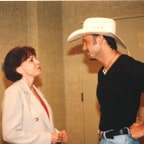WHAT’S THE BIG DEAL WITH BREATHING?
Having problems singing? Breathing may be the first issue you want to examine.
We all know that we need to move some air in order to sing, but why are the particulars so important? What’s the big deal with breathing? You would think since you’ve been doing this on your own from the moment you were born, you would have it down by now.
You can use your mind to direct the incoming air flow into almost any part of your body. But in order to do that, you need to exercise your imagination and be well acquainted with your body. You would be amazed at how elusive these two disciplines can be to some people.
Many of my new-to-singing students appear to never have been properly introduced to their own bodies. “Joe, meet your body.” “Body, this is Joe.” They seem to have little conscious control and a serious paucity of imagination. Not surprisingly, athletes and dancers are among those who seem to relate most quickly to the concept of specific singing breathing.
Now you might ask why this matters. It matters because wherever you imagine your air reservoir to be in your body, is where you will tighten to push the air back out again when you are singing. Breathing high up into your neck and shoulders forces you to tighten your throat to push out the air in order to sing.
Try this: put your thumb on your navel and imagine a ping pong ball resting just below that. This is your target area — the reservoir that will hold your air. Direct the air flow down as low as you can without actively pulling it in. It should still be part of your torso.
An important word of caution: Don’t ever fill your lungs with air. Never let them fill beyond your resting capacity. When you fill past that point, you must tighten your throat like a throttle valve to hold the air in. The more air you build up, the more your throat will tighten. The effect this has on a singer’s tone and pitch can only be negative. How much easier it is to simply open your throat and let the air fall into your lower abdominal area.
We put the air there so we can utilize the strong muscles of your lower body to push the air back out again for easy, free, singing breathing. It’s not so hard. Simply say “hello” to your body and use your imagination.
Here’s a video to help you understand lower body breath control.
If you found, and enjoyed this article and have not signed up for Renee's newsletter,
check it out below and stay tuned for lots of Renee's techniques, tips, and tricks.
"My Free Video Voice Lessons are a great way for singers to learn how to sing using good basic technique, as well as tips to help them make wise choices in their careers. It’s important to me that you learn how to breathe, support your sound and sing with emotion. They will help you get the basics down, so you can go straight to your individual needs as a singer. I hope you enjoy these videos as much as my students and I did putting them together." - Renee
Click on the Video for a message from Renee about her Free Video Newsletter.
YOU WILL LEARN: Singing with Emotion, Passive Breathing, Creative Phrasing, Sound Production, Career Planning and much, much more.
What others say about Renee's techniques.

Miley Cyrus
"I miss you so much! My voice is so much better now. I can hit high notes without sounding like a dying German Shepherd."

Tim McGraw
"Renee has my changed my whole approach. Her teaching has given me a lot more confidence in my singing ability."

Rod Essig
Creative Artist Agency
"...So When they have a little problem, I say here's a phone number to call."

Bob Weir
Grateful Dead, Bobby Weir & Wolf Bros
"Renee is the best vocal coach in the world!!!"

Mary Steenburgen Actress, Singer, Songwriter
"I think Renee is a genius!"
Check out Renee's Merch
Find lots of resources on our SITEMAP


